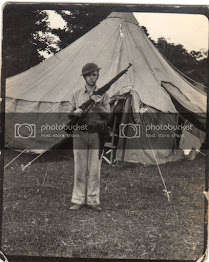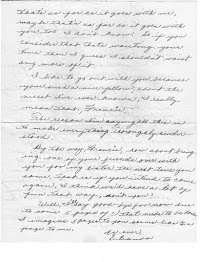A story from 80 years ago
Fall, 1941. A young draftee in the US Army meets a young woman in Los Angeles.
They go dancing. They write letters to each other. He works in the headquarters of a fighter plane squadron. He sends her a letter that he typed in the office.
She wrote him a letter that she either never sent or rewrote. Some is in shorthand, probably a connection they discovered, as he had gone to business college before being drafted and she was going to business college when they met.
The Japanese bombed Pearl Harbor on December 7, 1941. He was subsequently sent overseas.
He wrote her a letter in March, 1942 from his tent in India, of which he enclosed a photo with the letter (above).
She was excited to get it.
The young man mentions a place in Los Angeles where they danced called the Palladium. Here's a photo of the place from the time.
They kept on writing in 1942 and 1943. I can't stop looking at how he signed his name "Klyne." I can barely sign my name. It's a good thing my wife and I communicated by email when we met. A couple more of his letters below.
There are likely other letters but they have disappeared over the decades. He's not the only soldier she met, as she has a list, though he's near the top.
She writes a letter in 1944, though whether it was a draft or just never sent is unknown. By the time she wrote it, he was on his way back to the United States for medical reasons.
In late 1944 Klyne returned to the United States and married a different woman, Christine, who he'd met in Washington, DC before being drafted, posted to California, and meeting Eleanor. They have a couple children, of which I am one. Eleanor married and has a couple children as well.
In 2012 Klyne died, a month after his wife Christine died. Eleanor died the same year, two decades after her husband died. Her daughter found some diaries and letters saved for seventy years in her mother's attic and scanned selections from them and posted them in her blog. I happened to google Klyne, my father, about a year later and ran across his letters she had posted. I wrote a quick note in her comment section saying that I was his son.
Parents tell their families a narrative of their meeting, courtship, and marriage. Our family's was this: my parents met at a dance in DC in the early months of 1941 and spent time together. He was drafted in the spring of 1941, before the US entered the war, so they thought he'd return in a year and they'd get married. When he eventually returned three years later, they got together and got married. That's what they told us when we were kids. Evidently my dad was smitten with other girls as well, as young guys are. Eleanor's daughter was surprised as well when she discovered her mother's social life during the war in her diaries and saved letters.
The story of Klyne and Eleanor was likely repeated a couple million times during the war: infatuation, uncertain feelings, as well as desire for connection far from home and during uncertain times. It's a charming story, but I'm glad nothing happened between them after the war for the selfish reason that I wouldn't exist. But the story of Klyne and Christine was also repeated millions of times as well, and millions of Americans like myself are the children, grand-children, great-grandchildren, and great-great-grandchildren that came from such stories. I'm probably biased, but I like how that story ended.



 .
. 







 .
. 






Comments
Post a Comment